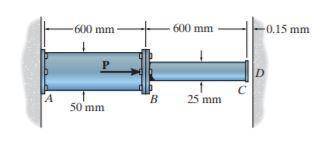
Physics, 28.01.2020 06:31, liapooh73p7b896
If the gap between c and the rigid wall at d is initially 0.15 mm, determine the magnitudes of the support reactions at a and d when the force p

Answers: 2
Other questions on the subject: Physics


Physics, 23.06.2019 10:30, jumeljean123oythxy
Abig box of sausages (30 kg) are lifted from the ground to the top shelf of the freezer. if the box is lifted at a constant speed, a distance of 1.75 m, what work is done by gravity?
Answers: 1


Physics, 23.06.2019 15:00, devontadunn4789
Basilisk lizards can run across the top of a water surface (see the figure). with each step, a lizard first slaps its foot against the water and then pushes it down into the water rapidly enough to form an air cavity around the top of the foot. to avoid having to pull the foot back up against water drag in order to complete the step, the lizard withdraws the foot before the water can flow into the air cavity. if the lizard is not to sink, the average upward impulse on the lizard during this full action of slap, downward push, and withdrawal must match the downward impulse due to the gravitational force. suppose the mass of a basilisk lizard is 93.7 g, the mass of each foot is 3.37 g, the speed of a foot as it slaps the water is 1.15 m/s, and the time for a single step is 0.531 as. (a) what is the magnitude of the impulse on the lizard during the slap
Answers: 3
Do you know the correct answer?
If the gap between c and the rigid wall at d is initially 0.15 mm, determine the magnitudes of the s...
Questions in other subjects:




Chemistry, 22.04.2020 04:10













